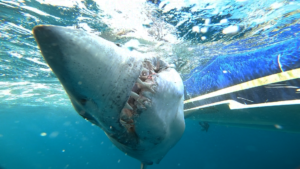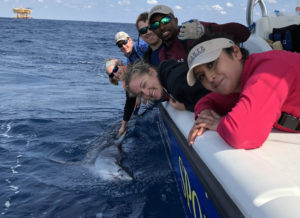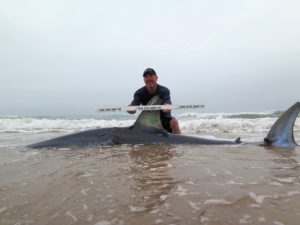
Story by Dr. Kesley Banks and Dr. Daniel Coffey
Dubbed the “marlin of the shark world,” shortfin makos are among the most iconic shark species, ranking high on many anglers’ bucket lists. Built like muscular torpedoes, makos are known for their speed and acrobatics when hooked, making for an impressive fight. The popularity of shark fishing has increased in recent years, coinciding with advances in tackle and technology that increase the chance of encounter and capture.
Today, we have faster engines, more precise electronics, and sophisticated reels that aid in landing trophy fish. As we have become more efficient in catching these fish, the need for conservation also increases. Sharks like the shortfin mako are apex predators in our marine ecosystems and help to keep the ocean in its delicate balance.
As a highly migratory species, makos can make long migrations crossing many international management jurisdictions, subjecting these sharks to varying degrees of fishing pressure and protection. Management of this species is complex and recently has become controversial. In 2017, the shortfin mako population in the North Atlantic was found to be overfished and undergoing overfishing (too many fish have historically and are currently still being removed from the population to be sustainable) by the International Commission for the Conservation of Atlantic Tunas, or ICCAT. ICCAT scientists reported that the population is so depleted that there is a 52 percent chance of recovery by 2070 if harvesting levels were dropped by at least 86-90 percent throughout the North Atlantic Ocean.

This bleak outlook sparked the International Union for Conservation of Nature to list makos as endangered on the Red List of Threatened Species and increased regulation on international trade under Appendix II of CITES, the Convention on International Trade in Endangered Species.
While no targeted commercial fishery exists in the United States for shortfin makos, they are caught as incidental bycatch in tuna and swordfish commercial fisheries and often retained because of their high-quality meat. Given the concern of their population status, in 2018 the United States required the safe release of any mako that was alive when retrieving commercial fishing gear, and only those dead at haul-back could be retained if an electronic observation system or scientific observer was onboard.
Additional regulations were implemented for the recreational fishery, which increased the minimum size retention for makos from 54 inches (4.5 feet) fork length to 71 inches (roughly 6 feet) for males and 83 inches (about 7 feet) for females. Because this species reproduces later in life (at around 18 years old for females), this increase in size helps protect more females from being removed from the population before having a chance to produce offspring. While the United States took a step in the right direction to protect these magnificent creatures, formal international agreement on conservation measures and management regulations are still contentiously debated.
Whatever the outcome, one thing is for certain, live releases will likely increase. Catch-and-release is a highly effective management tool, but only if done properly using best practices supported by sound science.
OFF THE BUCKET LIST

Mako sharks not only provide one of the most aggressive fights on rod and reel for recreational anglers, but their dramatic smile makes for an extraordinary photo. Hooking and successfully releasing a mako is fairly easy to do if you use these tricks.
First, catching one of these grinning sharks requires planning and the right tackle. To increase the chance of seeing your mako up close and its survival after release, you should use a heavier class rod and reel. Exact setups will vary based on your fishing style although you will want to use at least a 50-pound class rod and reel. The rod should be sturdy but have some give with smooth guides. Reels should have top drag systems and internal gears and hold large amounts of heavy line. This heavy line not only increases your chance of seeing your mako but also decreases the chance of the line breaking, which can ultimately leave tackle in the shark. Heavy tackle also reduces fight times, which could minimize exhaustion and stress of captured sharks, thus increasing the chance of successful release outcomes.
Second, your choice of terminal tackle can also increase survivorship after release. That impressive mako smile consists of sharp teeth that can easily bite through mono, so using a heavy wire leader is necessary. At the end of the wire leader is a non-stainless steel, non-offset circle hook required by NOAA when targeting sharks. These circle hooks not only corrode at a faster rate but also cause less injury because they are more likely to lodge in the jaw or corner of the mouth than J-hooks, which can lodge in more sensitive areas.
Once your mako is by the boat, keeping the shark in the water is critical. Makos are ram ventilators, meaning they constantly need water passing over their gills to breathe. Just a few moments of air exposure and improper use, even just for a photo, can greatly decrease the chance of survival after release. Instead, consider keeping the boat in low gear doing lazy circles to pass water over the gills as you lean down for your photo next to your catch.
When it’s time to remove the hook, use long bolt cutters to snip the hook. This method allows the safe removal of the hook for both the angler and the shark. If you cannot clip the hook, cut the leader as close to the hook as possible. Remember, never gaff a shark you are planning on releasing!
When caught and handled properly, released mako sharks are resilient and can have high survival, ensuring healthy and sustainable populations for future generations of anglers. For more information on catch-and-release best practices for many prized sportfish species, check out the ReleaSense initiative (www.releasense.org) to promote the survival of released fish using the best available science. If you are interested in helping the CSSC team, visit our website at www.sportfishcenter.org/participate/citizen-science for more information on how to get involved.
Kesley Banks, Ph.D. is a Postdoctoral Research Associate in the Center for Sportfish Science and Conservation at the Harte Research Institute for Gulf of Mexico Studies (HRI) at Texas A&M University-Corpus Christi. She graduated from Texas A&M University – Corpus Christi in December 2019 with a doctorate in marine biology and was one of the first recipients of a Science of Conservation Marine Scholarship. The Science of Conservation Scholarship program was founded in 2018 through a partnership of Shimano and CCA and is dedicated to benefitting students furthering their marine science education.
Dr. Daniel Coffey is a Postdoctoral Research Associate at the Center for Sportfish Science and Conservation at the Harte Research Institute for Gulf of Mexico Studies. He received his Ph.D. in marine biology from the University of Hawaiʻi at Mānoa, where his dissertation focused on using novel animal-borne tags to investigate how deep-sea sharks modify their behavior in response to changing environmental conditions.








